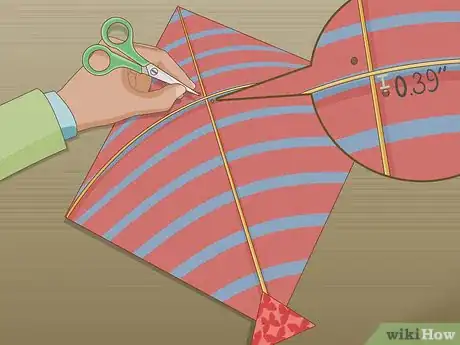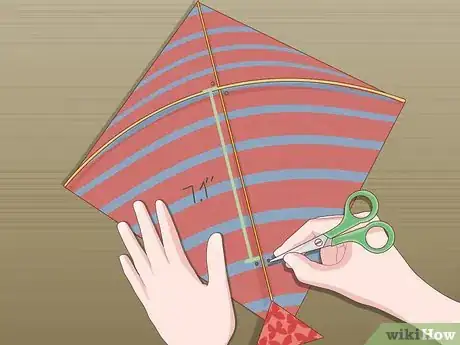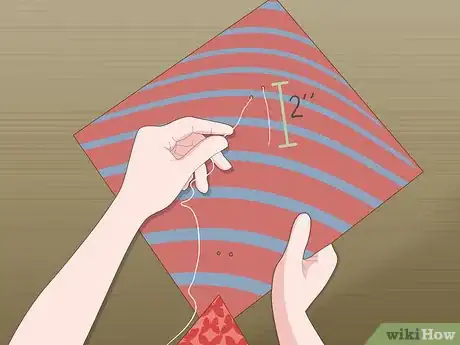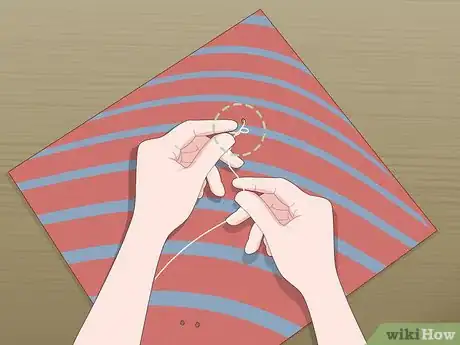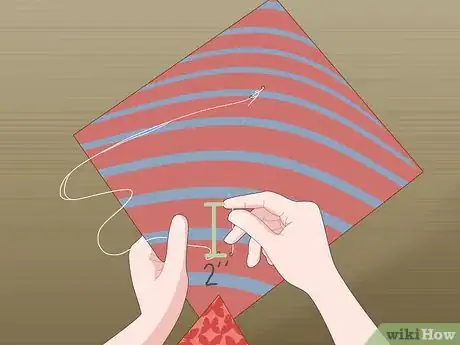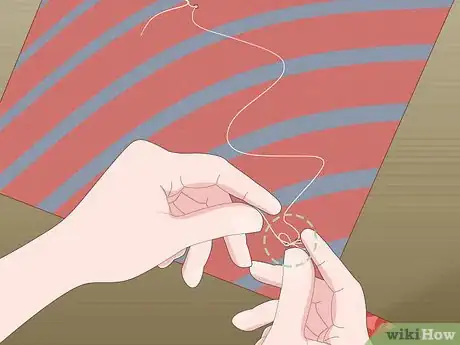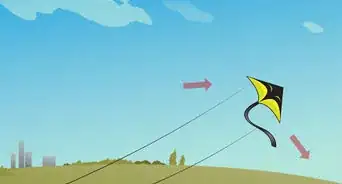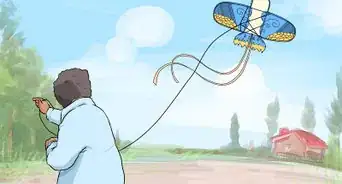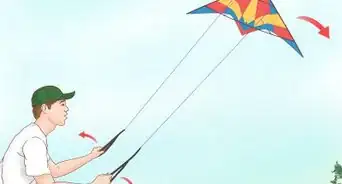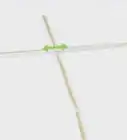This article was co-authored by wikiHow Staff. Our trained team of editors and researchers validate articles for accuracy and comprehensiveness. wikiHow's Content Management Team carefully monitors the work from our editorial staff to ensure that each article is backed by trusted research and meets our high quality standards.
This article has been viewed 216,122 times.
Learn more...
Kites provide endless entertainment for both children and adults alike. If your kite doesn’t come with string attached, you will need to thread and tie it yourself. Begin by making the holes, then thread the string through them and create knots to secure it in place. Finally, attach a long piece of string to the loop you have made to create the flying string. Have fun flying your kite!
Steps
Making and Threading the Holes
-
1Pierce 2 holes opposite each other at the intersection of the kite sticks. On the back side of the kite, there are 2 sticks. One of the sticks is vertical and the other is horizontal. Poke a small hole in the material of the kite, 1 centimetre (0.39 in) above the horizontal stick. Then, place another hole in the kite fabric diagonally opposite it, 1 centimetre (0.39 in) below the horizontal stick.[1]
- Use scissors or a sharp stick to make the hole.
- The kite sticks can be plastic or wooden.
-
2Create 2 more holes 18 centimetres (7.1 in) below the first holes. Measure 18 centimetres (7.1 in) below the intersection of the kite sticks. Then, make a small hole into the kite fabric either side of the vertical kite stick. Once again, make the holes about 1 centimetre (0.39 in) away from the kite stick.[2]
- If you don’t have a ruler, measure 1 hand-length instead of 18 centimetres (7.1 in).
Advertisement -
3Fold a 2 m (6.6 ft) piece of string in half. Purpose-made kite string works best for this activity, as it is able to withstand big gusts of wind. However, if you don’t have any, use regular twine instead. Fold the string to make it stronger and longer-lasting.[3]
- Purchase kite string from a sports store.
-
4Insert the thread into the top hole and back through the hole below. Place the folded end of the thread about 5 centimetres (2.0 in) through the top hole via the front of the kite. Then, pull the thread back toward yourself via the diagonally opposite hole. [4]
- Loop the string over the kite sticks when you thread the string back toward yourself.
-
5Double-knot the thread at the front of the kite. Hold the folded end of the string in 1 hand and the other end of the string in your opposite hand. Then, cross the folded string over the other end of the string and push the folded end through the loop that you created. Pull both ends of the string tight to create the knot. Repeat this process once more to secure the double-knot.[5]
- This common knot is often used to secure shoelaces.
-
6Thread the string through the bottom 2 holes. Push the long piece of string 5 centimetres (2.0 in) through 1 of the bottom holes on the kite. Don’t pull the string tight, instead, leave it loose to create a loop. Then, thread the end of the string back toward yourself through the other bottom hole.[6]
- When you thread the string through the second hole, make sure it goes over the vertical kite stick.
Creating the Knots
-
1Double-knot the string to secure it in place. Hold the 5 cm (2.0 in) section of string in 1 hand and the loop in your other hand. Then, use the section of string to create a double-knot. This prevents the string from coming undone.[7]
- Lightly tug on the knot to tighten it if it feels a little loose.
-
2Tie a knot on the loop of string 18 cm (7.1 in) away from the holes. Hold the loop of string away from the kite. Measure 18 centimetres (7.1 in) from the holes up each piece of string and make a mark. Take both of these points and knot them together to create a smaller loop.[8]
- This helps to balance the kite and allows it to fly straight.
- Trim off the excess string with a pair of scissors.
-
3Knot a long length of string to the loop that you have created. This length of string is what you will use to the fly the kite with. Take the end of the long string and double-knot it to the loop on the kite. Use a double-knot to prevent the kite from coming loose.[9]
- Consider wrapping your flying string around a piece of wood or tubing. This allows you to vary the length of the string and gives you more control over the kite.
Things You’ll Need
- Scissors
- 2 m (6.6 ft) piece of kite string (for tying the kite)
- Kite string (for flying the kite)
References
- ↑ http://hyderabad-india-online.com/2013/01/getting-kite-ready-to-fly/
- ↑ http://hyderabad-india-online.com/2013/01/getting-kite-ready-to-fly/
- ↑ https://youtu.be/_7arIGIBnQA?t=128
- ↑ https://youtu.be/PCanD1dy84w?t=57
- ↑ https://youtu.be/_7arIGIBnQA?t=183
- ↑ http://hyderabad-india-online.com/2013/01/getting-kite-ready-to-fly/
- ↑ https://youtu.be/_7arIGIBnQA?t=232
- ↑ https://youtu.be/_7arIGIBnQA?t=310
- ↑ http://hyderabad-india-online.com/2013/01/getting-kite-ready-to-fly/
About This Article
To tie a kite string, start by making the holes for the string to pass through. Turn the kite over so you can see the back side and pierce two holes diagonally opposite from each other at the intersection of the kite sticks. Then, make two more holes 7 inches below the first holes, with one on either side of the vertical stick. After you’ve made the holes, get a 6 1/2 foot piece of kite string. Thread the string through the top hole and then back through the hole below it. Double knot the thread and insert it through the bottom two holes. Once you’ve threaded the string, knot it in place to prevent it from coming undone. For more information on tying a kite string, like how to knot the string to balance the kite, read on!
